W.86 from the Walters Art Museum is an early manuscript from Arras, near Calais. It dates to the late 13th century, making it an early example. Like many 13th C Hours, it has some unusual contents, in this case a series of six miniatures depicting the Passion between the Calendar (1r-12v) and the Hours of the of the Virgin, which start with a striking full-page historiated initial on f.19r. The Calendar is also interesting both due to it being in Old French and due to the large number of errors and unidentified saints. There are 17 errors and 47 unidentified entries, or roughtly 30% of the 198 total. Some of the unidentified saints have clear readings, but have no matching known feast. Others, such as Waubort on November 15(see f.11r below), are French translations of known saints, in this case St Walburga, but still are unmatched for the date.
(DB Id: 256)
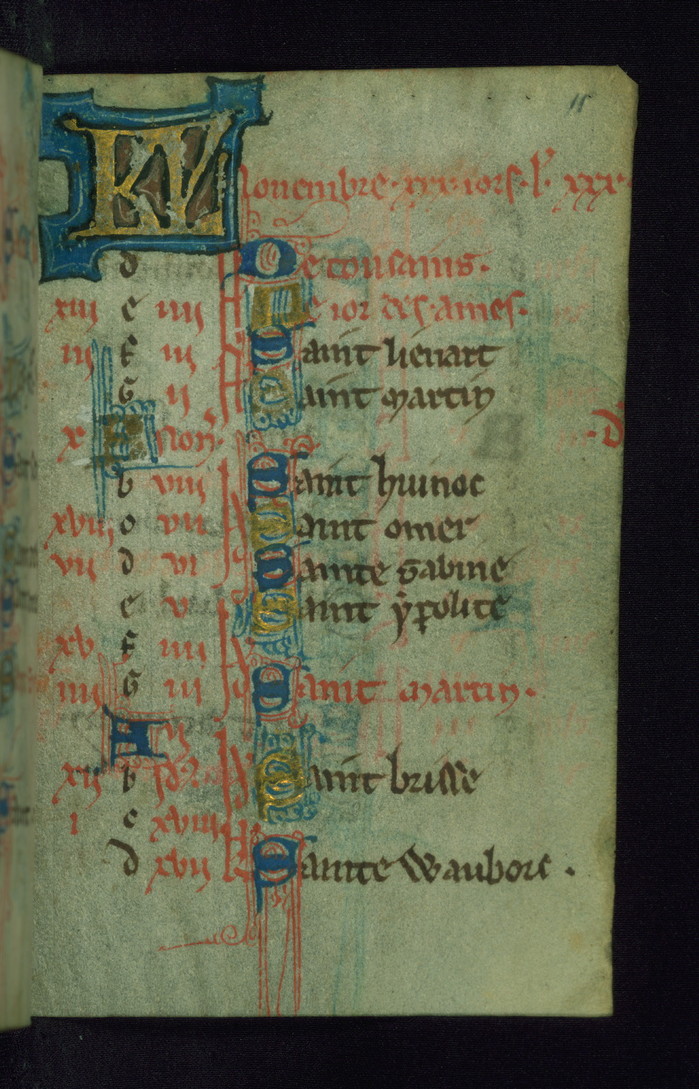
It’s not linked into all the proper places, but the initial “date detail” function is finally implemented. In the same basic mode of operation as “saint detail”, this returns a page with all the entries known for a particular date, as well as information about that date (currently Dominical Letter, Golden Number, and Roman Date). Future work will include some distribution graphs and a “Notes” field for the date, but at least there is a minimal function out there. Currently it is only linked from the date number in the “Saints by date” page, but that may increase.
There are a pair of permanent links, one as date id: http://cokl.wiglaf.org/p/v100/dateid/210
and another as the month/day: http://cokl.wiglaf.org/p/v100/date/7/29
Back to Bibliothèque de Genève manuscripts, hosted by the excellent e-Codices. MS Lat 367 is a book made in Lyon for the Use of Geneva, which is an uncommon liturgical localization. It dates to the early 16th century, but post 1511 as some of the illustrations by the Maître de l’Entrée de François I are based on images in Durer’s 1511 Petite Passion.
The calendar is not complete, but nearly so with 359 entries and a few non-feasts indicated, such as “Dies Egyptia” on March 28. The entries have some accuracy issues, with at least 12 on the wrong date. There’s also an interesting scribal error in September (see f.10r below), where Cornelius and Cyprianus (3696) are listed on both the 14th, the correct date, and on the 13th as well. Many of the identified saints are unique or rarely seen in other calendars.
(DB Id: 249)
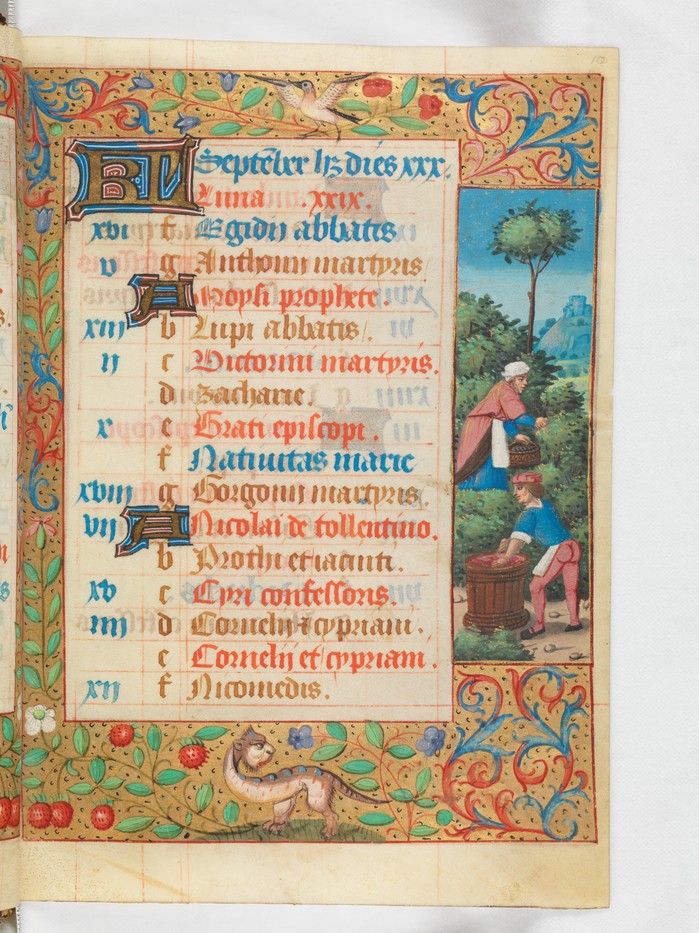
Taking a break from the e-codices stuff, the Vatican uploaded one of their Sanvito Books, Vat.lat.9490. This one is both Use of Rome and made in Rome, and entirely on purple vellum. The calendar is written in gold and silver, with silver for the high-importance feasts and gold for the regular. The calendar is exceptionally accurate, 2 saints are offset a single day and not a single one is unidentifiable, out of 205 entries. There is a decidedly Fransiscan slant to the saints, with the feast of his Stigmatization(3722) and the Translation of St. Clare(3359), both in silver, and the Octave of his Feast(3992) and the feast of Peter Martyr(273), both in gold. In an unusual bit of scribal whim, some few saints are written as "Saint Martyr Name", versus the more common "Saint Name Martyr", for example see Trifonis & Respici on November 10, below f.13r
(DB Id: 251)
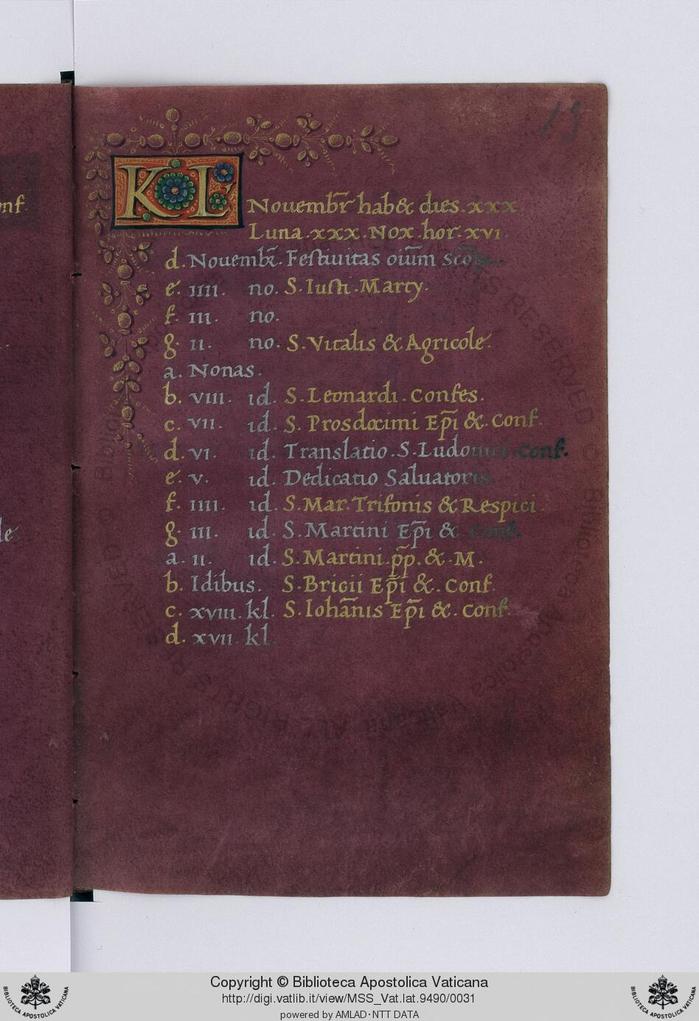
We know more about the location of manuscript MS Lat 34 from the Bibliothèque de Genève, hosted by the excellent e-Codices, than we usually do. This was made for use in the Abbey of St. Martin, in Tours, France. Sadly the monastery was destroyed during the revolution due to St. Martin’s connection to the royal family, dating back to Clovis. The modern Basilica of St. Martin was built on the same site in the late 19th century.
The calendar is unusual in containing a large amount of non-festal dating. All of the Egyptian days are marked in full and there are the “keys” to both Rogation and Pentecost, though not for Easter, which is the most common. For Easter, there is a little poem on the outer margin of the first part of January (see f.3r below) that gives a simplified way of predicting the date. There’s also an entry for the day of Creation, according to Bede and the yet-unexplained “Septim[us] embolism[us]”. The saints are as expected. There are several feasts for St Martin, including the common, Translation on July 4 1854, and the uncommon, Subvention on May 12 2543, Octave of Translation on July 11 4220
(DB Id: 246
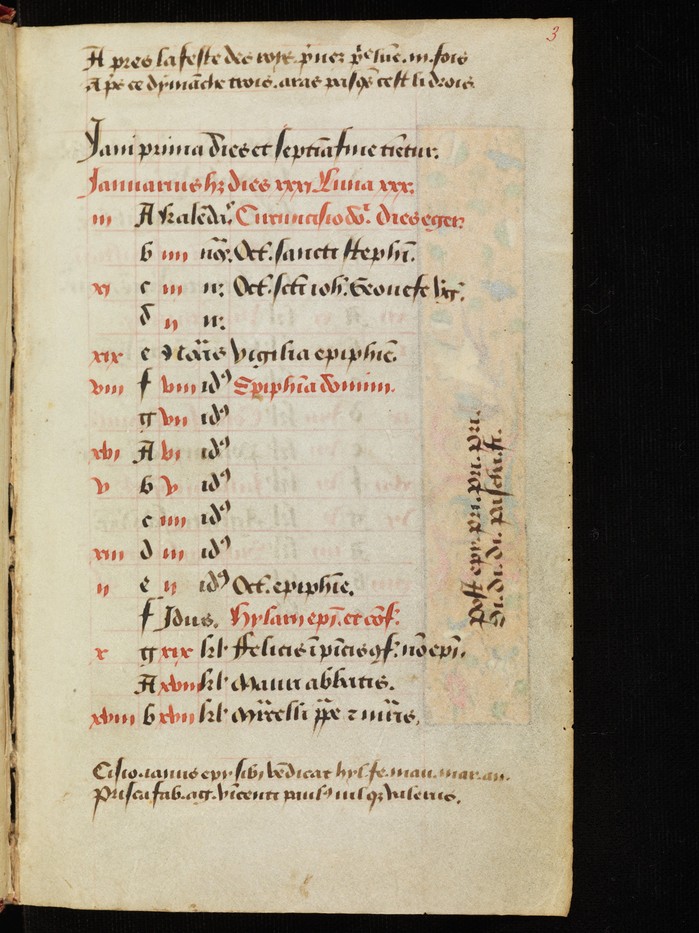
No new manuscripts so far this week, but there have been some useful improvements under the covers, including finally starting work on the last piece of obvious simple functionality:
- Unit tests for the html class. Somehow I never wrote these, well they are now in place for the html_error function
- Beginning work on standardized argument processing. The code is in place for CGI variables to be verified if they are meant to be an integer in a range. Currently this is only in use by the date_detail function, which is not complete, but it will be extended to other places where an integer is expected. Note that this is part of the html class, but not yet unit tested.
- Started work on the date_detail function. This will display all known entries for a given date, either as day number or as month/day. Incomplete, but at least work has begun finally
- Moved the grid of entries out of the template for the saintdetail to a stand-alone template. Hopefully will be reused by the datedetail function
The another manuscript from the Bibliothèque de Genève, hosted by the excellent e-Codices site, was made for use in Nantes, MS Lat 33. It is lavishly decorated throughout, with block-borders on almost every text page and filled pages to start the hours and each month in the calendar.
The calendar is unusual in that it is unranked. There is a strick alternation of blue/gold for the entries, with no distinction for high-importance feasts. Also somewhat unusual is the line-fillers for every day. The saints are rather error-prone, with at least 43 noted on the wrong date. Several more names have become quite corrupt, for example St. Ballece, December 3 (see f.12r below), is most likely meant to be St. Barbara, December 4 853
(DB Id: 241)
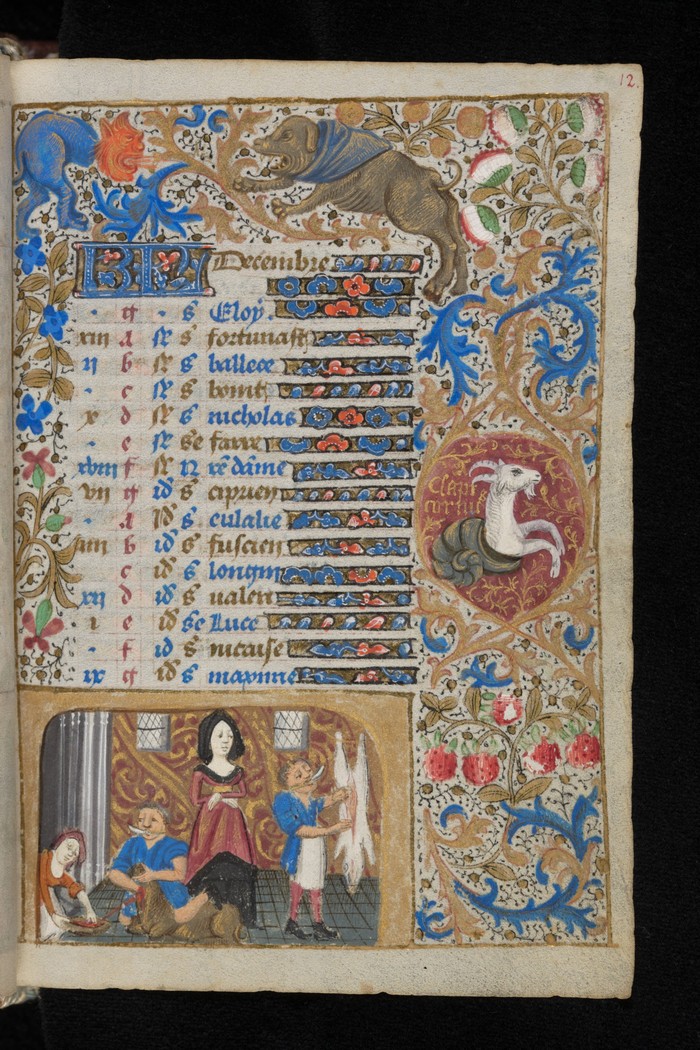
A code update was pushed along with the addition of this MS to properly store manuscripts with unranked saints. This is unusual, so far there are only 3 manuscripts in which the color change does not seem to impart any sort of ranking information. One further manuscript, the oldest in the DB (DB Id: 68), only has black text in the calendar.
The other digitized hours from the Comites Latentes collection of the Bibliothèque de Genève, hosted by the excellent e-Codices site, was made in Tours for a customer from Toulouse, Comites Latentes 124. Two of the miniatures are by Jean Bourdichon, the rest by the workshop of the equally distinguished Jean Poyer.
The calendar is rather unusual on the page. The ruling is more complex than usual, with seven ruled columns, the main set off with double-lines. The saints are in black, with gold for the important and red for vigils, but most of the gold has flaked off. The Egyptian Verses and the name of the month are in silver, which has aged very well with little loss or oxidization. The entries are very accurate, with only 6 of 240 unknown and a few more unidentified. An unusual, actually unique so far, entry is the Vigil for Candlemass 4212.
(DB Id: 240)
From the Bibliothèque de Genève, hosted by the excellent e-Codices site, comes a late 15th Florentine Book of Hours, Comites Latentes 54. The book is in a very careful and decorative Italian Gothic, with a couple of the highly-ornate borders that often accompany this scribal hand. The calendar is mosthly empty, with only 128 total entries, about 1/2 ranked high. As common in Italian books there’s a high-than-usual count of popes, and some specific local entries, such as the rare St. Zenobious of Florence 4072.
(DB Id: 239)
From a new source, the Archives of the Canton of Vaud, comes a nice Parisian Book of Hours, shelfmark P. Château de La Sarraz H 50. As a Swiss Cantonal library, this manuscript is comprehensively catalogued and digitized in e-Codices. Helpfully for localization and dating, this has a colophon* on f. 193v stating that it was made in the workshop of the Parisian bookseller Jacquet Lescuier in 1421 and bought, though possibly not comissioned, by Jean II de Gingins.
The calendar is not terribly unusual for a Parisian complete calendar, with just red and black entries. There are some errors, but no more than expected with a complete calendar. A couple of the entries are unclear due to the gothic biting.
(DB Id: 237)
* Ces heures sont a Jehan de gingins seigneur duione et capitaine surgens darmes pour le roy nostre sire. Et furent faites a larue neufue n[ost]re dame par iaquet lescuier. Lan .mil.CCCC.XXI.




